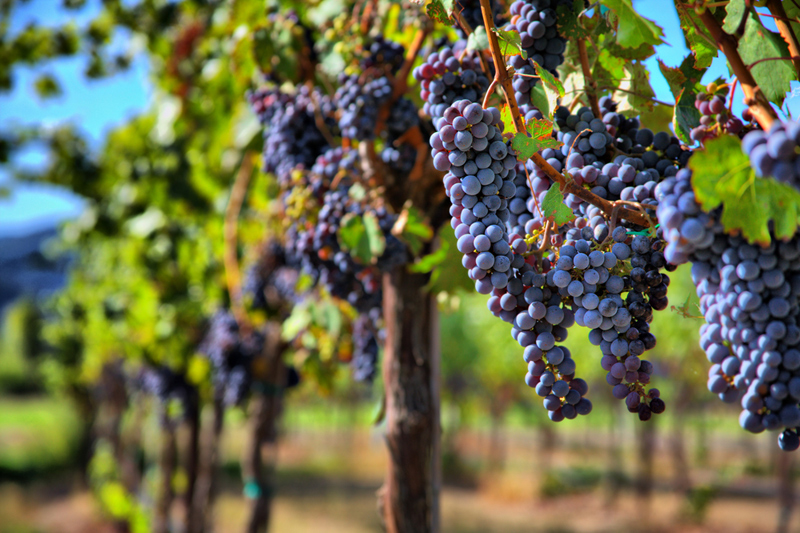Merlot is a juicy, elegant, and versatile red grape variety that’s grown around the globe, but it’s world famous for its role in the luxurious blends of Bordeaux. While Merlot’s characteristics vary depending on the climate, soil, and winemaking techniques, wines made with the grape are typically dry and can show flavors of red and black fruits, softer tannins, and medium to medium-high body and acidity.
Merlot In 60 Seconds:
- In Bordeaux, Merlot makes some of the most expensive and sought-after wines in the world.
- Merlot thrives in many winemaking regions and is often considered a workhorse grape, suitable for blending. It is grown around the world — throughout the United States and in Italy, Chile, South Africa, Australia, and even China — but is most celebrated in its homeland of Bordeaux.
- Merlot’s versatility makes it hard to pin down to just one style, earning it a chameleon-like reputation that changes based on where it is grown.
- After Cabernet Sauvignon, Merlot is the second most popular red wine in America
- Merlot can be aged for decades.
- Merlot’s moderate tannins and velvety texture make it a great match for a wide variety of foods and cuisines.
Looking for a bottle to drink? Check out our regularly updated list of the best Merlot bottles!
The History of Merlot
Merlot began as a cross-pollination between Cabernet Franc and an obscure grape known as Madeleine Noire des Charentes. The grape’s recorded history can be traced back to Bordeaux in the late 1700s, when a French winemaker mixed Merlot with Cabernet Sauvignon with satisfying results. The rest is history, as the Merlot grape became a beloved staple of the region, named after the “merlau,” a local blackbird species — likely due to Merlot’s dark hue or because the bird enjoyed eating the thin-skinned grape.
Centuries later in California, Merlot’s easy-drinking reputation helped it gain traction in the 1990s and early 2000s. In 2004, Merlot’s popularity took a hit following the success of award-winning movie “Sideways,” in which the lead character Miles famously maligns the grape. Later dubbed the “Sideways Effect,” the cultural phenomenon, along with the grape’s already plunging reputation, is believed to have helped skyrocket Pinot Noir’s success in America.
What Does Merlot Taste Like?
Often compared to Cabernet Sauvignon, Merlot is a softer, gentler option, with lower tannins, acidity, and generally a lighter body, with tasting notes of black cherries, blackberries, plums, cocoa, and violets. When grown in warmer climates, the grape shows juicier, fruity notes with higher alcohol and moderate tannins. When grown in cooler climates, however, Merlot can be similar in structure to Cabernet with grippy tannins and herbaceous, peppery notes.
The World’s Best Regions for Growing Merlot
Merlot shines in France, especially in the southwest region of Bordeaux, where its wines are highly sought after. It’s the dominant grape in the blends of the Right Bank, specifically the appellations of Saint-Emilion and Pomerol. There, the grape thrives in clay and limestone soils and is blended with Cabernet Franc, Cabernet Sauvignon, Malbec, and Petit Verdot. Merlot is also used in the wines of the Left Bank, blended in small amounts with Cabernet Sauvignon.
Outside of France, the grape is associated with many winemaking regions around the world. In Italy’s Friuli region, located at the foothills of the Alps, and further south in Tuscany, Merlot is used for varietal wines and as a blending grape.
In California, Merlot continues to make solid wines in Napa and Sonoma Valley. Outside the Golden State, winemakers in Washington and New York, particularly in the Finger Lakes and Long Island’s North Fork region, are also making high-quality wines with Merlot.

Famous Blends That Include Merlot
Many of Bordeaux’s famous châteaux include varying amounts of Merlot in their blends, while two of the most expensive wines in the world, Château Pétrus and Château Le Pin, are made with 100 percent Merlot.
How to Pair Merlot With Food
Merlot’s soft tannins and fruitiness make it an approachable and food-friendly wine that’s equally enjoyable sipped alone as it is paired with a wide range of foods. Lighter meats such as chicken and roast turkey are an excellent match, as are hamburgers, duck and pork with sweet sauces, and tomato-based pasta dishes. When it comes to the classic, more structured wines of Bordeaux, protein-rich dishes such as steak frites, grilled lamb, hearty stews, and roasted vegetables are all worthy companions.
